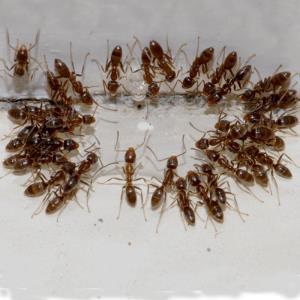Ecological Effect of Insect Control: Balancing Effectiveness With Sustainability
The environmental effect of parasite control is an essential issue that calls for a delicate equilibrium in between accomplishing effectiveness in making sure and taking care of bugs sustainability of our communities. From the usage of harmful chemicals that seep into our soil and water to the unplanned effects on non-target species, the consequences of traditional bug control techniques are far-ranging.
Harmful Chemicals in Insect Control
The use of dangerous chemicals in parasite control poses considerable environmental and health and wellness dangers that call for mindful consideration and mitigation techniques. Herbicides, pesticides, and chemicals are frequently utilized to remove parasites, but their widespread application can lead to unintended consequences. These chemicals can infect dirt, water sources, and the air, affecting not only the targeted pests yet likewise helpful bugs, wildlife, and human beings.

To attend to these dangers, incorporated bug monitoring (IPM) strategies are being advertised as an extra lasting choice. IPM entails a mix of techniques such as organic control, habitat control, and the targeted usage of chemicals as a last option (ant control faquay varina nc). By adopting a holistic approach to pest control, we can minimize the ecological and wellness influences linked with hazardous chemicals while efficiently handling pest populations
Influence On Non-Target Types
Taking into consideration the unintended repercussions of pest control methods, the effect on non-target species is an essential aspect that needs extensive assessment. While pest control steps intend to target particular pests, other microorganisms in the environment may be unintentionally affected. Non-target types, including useful bugs, birds, animals, and even plants, can endure direct or indirect injury from pesticide applications or biological control techniques.
Insecticides created to combat a certain insect bug may hurt pollinators like or all-natural predators such as ladybugs. Biological control representatives, if not species-specific, can posture risks to unintentional targets, interrupting the environmental equilibrium.
To minimize the influence on non-target species, integrated bug administration (IPM) approaches that stress an all natural approach to pest control are recommended. These methods prioritize the use of eco-friendly techniques, decreasing injury to useful microorganisms while properly taking care of pest populaces. Performing thorough risk analyses and keeping an eye on the results of parasite control initiatives are necessary actions in guarding non-target varieties and advertising total environment health and wellness.
Dirt and Water Contamination
Unexpected environmental repercussions of pest control techniques expand beyond affecting non-target varieties, with considerable effects for soil and water contamination - ant control. Pesticides, herbicides, and chemical plant foods used in bug control can seep into the dirt and contaminate groundwater, posing a risk to both earthbound and aquatic ecological communities.
Water contamination is one more essential problem linked with pest control practices. Runoff from farming areas treated with pesticides can carry these chemicals right into nearby water bodies, influencing water organisms and water high quality. Contaminants in water sources can have far-ranging consequences, affecting not just water life yet additionally human wellness via the intake of contaminated water or aquatic microorganisms. To alleviate dirt and water contamination from parasite control tasks, incorporated parasite monitoring strategies that focus on sustainability and decrease chemical inputs are essential.
Air Air Pollution From Pesticide Use
Exposure to airborne chemicals during agricultural applications poses a considerable issue for air pollution control measures. Additionally, pesticide drift, where pesticides are carried by the wind to unplanned locations, can lead to the contamination of close-by environments and water bodies.

Strategies for Lasting Pest Control
In the realm of farming practices, executing lasting pest control techniques is vital for keeping environmental equilibrium and guarding more plant yields. Sustainable insect control highlights using eco-friendly approaches to take care of pest populations efficiently while lessening injury to non-target microorganisms and communities. Integrated Bug Monitoring (IPM) is an extensively adopted method that integrates organic, social, physical, and chemical control approaches to attain long-term insect monitoring remedies.
Plant turning and diversification are additionally efficient techniques to interfere with pest life cycles and produce much less positive conditions for parasites to flourish. Inevitably, by integrating these lasting bug control strategies, farmers can attain a balance in between pest management performance and environmental stewardship.
Conclusion
Finally, the environmental influence of pest control techniques should be carefully thought about to balance efficiency with sustainability. Hazardous chemicals used in bug control can lead to soil and water contamination, air contamination, and harm non-target types - ant control. It is critical to execute lasting pest control techniques to decrease these negative impacts on the setting and promote a healthier environment for future generations
By taking on a holistic technique to pest control, we can decrease the environmental and health and wellness effects linked with harmful chemicals while efficiently taking care of pest populaces.

To alleviate the air pollution created by pesticide usage, it is crucial to take on integrated parasite management approaches that prioritize the usage of non-chemical pest control techniques, such as plant rotation, all-natural predators, and immune crop ranges. Lasting insect control stresses the use of ecologically pleasant methods to take care of pest populations properly while minimizing damage to non-target microorganisms and communities. Integrated Parasite Management (IPM) is a commonly taken on strategy that combines biological, social, physical, and chemical control approaches to achieve long-lasting bug management services.
Comments on “Premier Termite Control Services: Make Certain Long-Term Defense for Your Property”